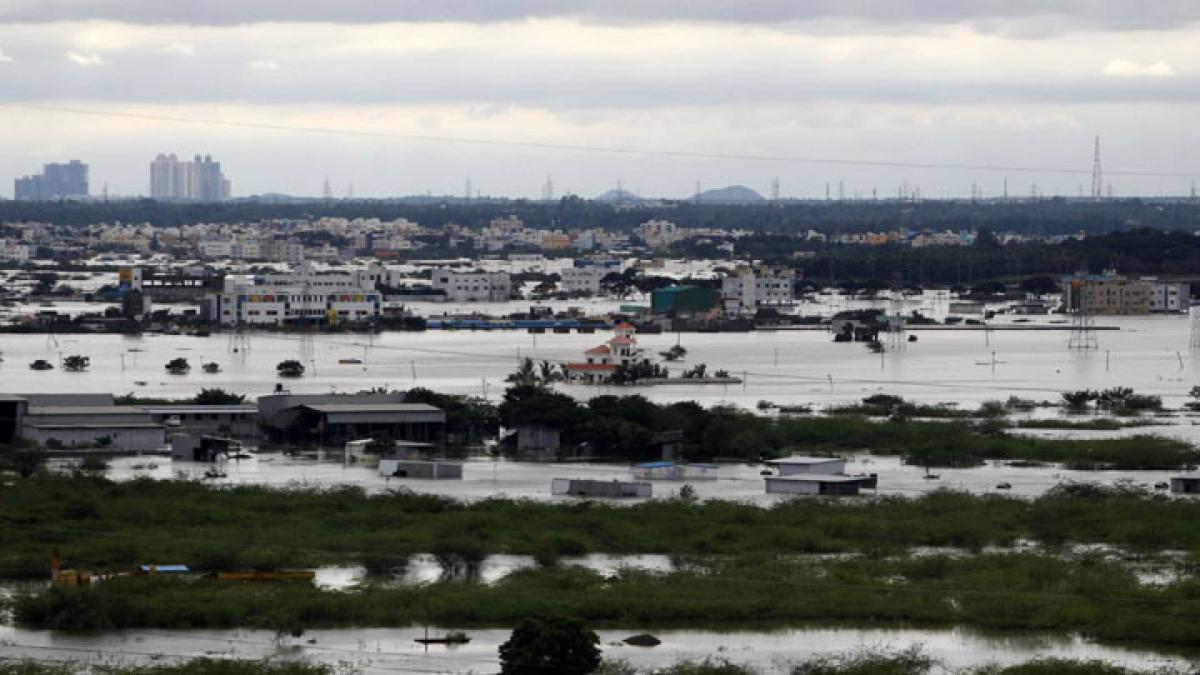Live
- High-street fashion players looking at India for manufacturing: Report
- Shreyas Iyer to lead Mumbai as Prithvi Shaw returns for Syed Mushtaq Ali Trophy
- 'Failed to resolve crisis': NPP withdraws support from BJP govt in Manipur
- Chennai: Actress Kasturi Remanded in Custody Until 29th of This Month
- Aaqib Javed likely to become Pakistan's new white-ball head coach
- BJP panel to draft poll charge sheet against AAP govt in Delhi
- Allu Arjun Thanks Fans in Patna, Teases 'Pushpa 2' Release
- Japan to strengthen measures against illegal part-time jobs
- Gahlot resignation: Delhi Congress calls AAP a sinking ship
- Consultative body on doctors' walkout fails to narrow differences in South Korea
Just In

Chennai has received over 300 mm of rainfall in the last few days, enough to fill up a one-foot tall bucket kept in the open. That is a lot for Chennai – it is three-quarters of its average rainfall of the entire monsoon.
 Chennai has received over 300 mm of rainfall in the last few days, enough to fill up a one-foot tall bucket kept in the open. That is a lot for Chennai – it is three-quarters of its average rainfall of the entire monsoon.
Chennai has received over 300 mm of rainfall in the last few days, enough to fill up a one-foot tall bucket kept in the open. That is a lot for Chennai – it is three-quarters of its average rainfall of the entire monsoon.
The government says the excess rainfall is actually once-in-a-century event. But are we to only blame the gods? Or global warming, or El Nino? Afterall, if it rained this much in Chennai 100 years ago, why haven't we heard of a similar disaster from then?
There's something wrong about the way the city developed since, and activists have been saying this for years. For Chennai, the principal argument is this: While you can't predict such heavy rainfall, #ChennaiFloods is actually because of ignoring natural drains and lakes, by building over them or turning them into landfills.
Even the government's top weatherman Laxman Singh Rathore knows this. Speaking on 2 December, the Indian Meteorological Department head said the exceptionally high rainfall isn't to be fully blamed. He said that the real reason for flooding is that there is no space for the water to drain out. Indeed, there is a sad irony to the Chennai deluge – it happened in a city next to the Bay of Bengal. All the water should have simply drained into the sea, like it has for centuries.
And this isn't just about stormwater drainage. Chennai has actively blocked its network of lakes, rivers, canals, wetlands and marshlands that absorb rainwater or divert it to the sea. Colonies, malls, universities and IT offices have been built over them. Where else will the water go?
Here's one example: soon after the November floods Chennai-based journalist and activist Nityanand Jayaraman posted this picture about a pond in the city that has now become a dumping ground for fly ash. The water "may have entered other people's houses if this pond hadn't been there" Jayaraman wrote. The city's water authority plans to convert it into a (closed) two-story water tank. Will it learn its lessons now?
After the last floods, another major encroachment that got exposed was the Ennore creek. It seems that parts of the 400-acre water body were getting reclaimed by Kamaraj Ports, while other parts were used to dump waste. Besides ruining its natural drains, Chennai has done nothing to build effective stormwater drains. The drains are built without even considering basic factors like slopes, proximity to other water bodies or roads.
All this isn't news. When Chennai had first flooded a month ago, it rang bells all way in Mumbai, another coastal metro with heavy rainfall and rampant real estate growth. Hearing a petition, the Bombay High Court on 27 November told city officials to specifically protect mangroves and wetlands to prevent a Chennai-like disaster.
The government's reply is just frightening – it reportedly confessed to the court that it doesn't even have a proper map of such water bodies in the city. The same has repeated in Chennai. After another flood in 2005, city officials decided to make terrain maps of the city using high-tech lasers from a helicopter. The project has still not taken off, literally. There is also no early warning system, even though this has been developed.
Experts say that the root cause is that urban planning in India has never taken water flow seriously, especially natural water bodies like lakes and streams. "This not only deprives the city of having its own water resources, it instead creates disasters like the one in Chennai," said Himanshu Thakkar of the South Asian Network for Dams, Rivers, and People.
According to Thakkar, there are many parallels between Chennai and Mumbai, where floods are now an annual affair. "Chennai has destroyed its water bodies the same way Mumbai had. Now Mumbai's disaster from a decade ago is repeating in Chennai," he said, referring to the 2005 deluge in Mumbai where over 1,000 lives were lost.
Postscript: After the last floods, this sketch made by a Chennai student was circulated on Facebook. The last image is a tragically accurate prediction of what you've seen on TV since yesterday. (Courtesy: http://www.catchnews.com)
By Nihar Gokhale

© 2024 Hyderabad Media House Limited/The Hans India. All rights reserved. Powered by hocalwire.com







